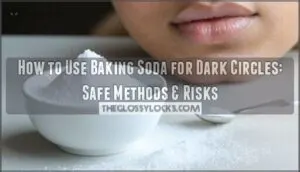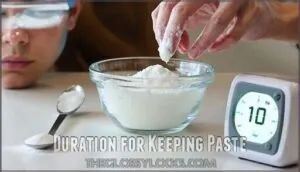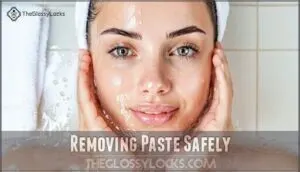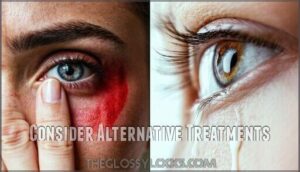This site is supported by our readers. We may earn a commission, at no cost to you, if you purchase through links.

Combine one teaspoon of baking soda with just enough water to form a thick consistency.
Gently pat this mixture under your eyes, avoiding direct contact with the eye itself.
Leave it on for only 2-3 minutes before rinsing thoroughly with cool water.
While baking soda’s exfoliating properties might help brighten dull skin, its high pH level can irritate the delicate under-eye area.
Think of it as using sandpaper on silk—sometimes the cure is worse than the problem.
There are gentler, more effective approaches worth exploring, and considering the potential irritation, it’s crucial to prioritize the delicate under-eye area’s health.
Table Of Contents
- Key Takeaways
- How to Use Baking Soda for Dark Circles Under Eyes?
- How to Apply Baking Soda for Dark Circles
- Mixing Baking Soda and Water
- Applying Paste Gently Under Eyes
- Duration for Keeping Paste
- Removing Paste Safely
- Benefits of Exfoliation
- Risks of Baking Soda’s Alkaline PH
- Concerns of Skin Irritation
- Avoiding Eye Contact
- Consider Alternative Treatments
- Frequently Asked Questions (FAQs)
- Can baking soda remove dark circles?
- How long to leave baking soda under eyes?
- Is baking soda safe around eyes?
- What is the fastest way to get rid of dark circles?
- Does baking soda remove dark circles under eyes?
- What does baking soda do to your eyes?
- What happens when you spread a little baking soda under your eyes?
- How frequently can I use baking soda?
- Does baking soda help with eye wrinkles?
- Can baking soda improve skin tone?
- Conclusion
Key Takeaways
- You can create a baking soda paste for dark circles, but it’s risky – Mix one teaspoon with water to form a thick consistency, apply gently under eyes for 10-15 minutes maximum, and never exceed once weekly use due to potential skin damage.
- Baking soda’s high pH disrupts your skin’s natural barrier – Its alkaline nature (pH 8.3) can cause irritation, redness, and micro-tears in the delicate under-eye area, often making dark circles appear worse rather than better.
- You’ll find safer alternatives that actually work better – Color-correcting concealers provide immediate results, while vitamin C serums, caffeine-based eye creams, and cold compresses offer proven benefits without the irritation risks.
- There’s no scientific evidence baking soda removes dark circles – Despite popular claims, this DIY remedy lacks research backing and can potentially worsen your appearance through skin barrier damage and inflammation.
How to Use Baking Soda for Dark Circles Under Eyes?
Why do so many people turn to baking soda for dark circles under eyes? This popular home remedy promises quick results, but separating fact from baking soda myths requires careful consideration.
To try this DIY dark circles treatment, mix 1-2 teaspoons of baking soda with water until paste-like. Test on a small skin patch first—your delicate under-eye area deserves caution. Apply gently using fingertips, avoiding direct eye contact.
While baking soda might seem like a quick fix, your delicate under-eye skin deserves gentler, science-backed solutions that actually work.
Regarding application frequency, limit use to once weekly maximum. Expected results vary widely, with some reporting temporary brightening effects. However, skin’s pH balance may be disrupted by baking soda’s alkalinity. long-term effects may include skin irritation and pH disruption.
Before diving into this baking soda remedy, consider that safer alternatives exist. Professional treatments and quality eye creams often deliver more reliable results without compromising your skin’s natural barrier.
How to Apply Baking Soda for Dark Circles
Applying your baking soda paste for dark circles requires careful technique to avoid irritation. Here’s your step-by-step approach:
- Perform patch testing on your inner wrist 24 hours before first use
- Check paste consistency – it should feel smooth, not gritty or runny
- Choose application tools wisely – clean fingertips or cotton swabs work best
- Apply gently in dabbing motions, never rubbing the delicate under eyes area
- Plan post-application care with a gentle moisturizer ready for afterward
Start by dipping your chosen tool into the mixture. Gently dab the baking soda remedy under each eye, staying at least half an inch from your lash line. Don’t spread it like face cream – think more like applying concealer.
The application frequency should never exceed twice weekly, as your skin needs recovery time between treatments.
Mixing Baking Soda and Water
Getting your paste consistency right sets you up for success. Start with 1-2 teaspoons of baking soda in a clean bowl. The water ratio matters more than you’d think – add drops gradually while stirring with a small spoon or clean finger. Your mixing tools can be simple: a teaspoon works perfectly.
Keep adding water until you achieve a thick, spreadable texture that won’t drip down your face. Think peanut butter consistency rather than soup. For those interested in purchasing baking soda, there are many online retailers.
Here’s what different consistencies mean for your DIY mask:
| Consistency | Water Amount | Result |
|---|---|---|
| Too Thick | Minimal water | Won’t spread evenly |
| Just Right | Gradual drops | Stays put under eyes |
| Too Thin | Excess water | Drips and irritates |
This baking soda paste becomes your foundation for addressing dark circles under eyes. Getting the mixture right prevents waste and makes certain your DIY recipes work as intended.
Applying Paste Gently Under Eyes
Once you’ve mixed your baking soda paste, proper application techniques become your best friend for avoiding skin sensitivity issues. Think of this step like painting a delicate watercolor – gentle strokes work better than heavy-handed pressure.
Here’s how to apply your DIY mask safely:
- Use clean fingertips or a soft spoon to dab the paste under eyes
- Focus on dark circles specifically rather than spreading everywhere
- Pat gently instead of rubbing to prevent irritation
- Keep paste away from your actual eyelid to avoid contact with eyes
The paste consistency should feel smooth against your skin. Remember, this home remedy works through exfoliation, so less pressure means better results. Before applying, consider that fatigue may contribute to dark circles. Your under-eye area is incredibly delicate – treat it like silk, not sandpaper.
Duration for Keeping Paste
Timing often makes the difference between effective treatment and skin damage when using baking soda for dark circles under eyes. The ideal time for keeping this home remedy on your delicate under-eye area is 10-15 minutes maximum.
This duration allows gentle exfoliation without overwhelming your skin’s natural pH balance. Before applying, always perform patch testing on your inner wrist, especially if you have sensitive skin.
Start with shorter durations initially to gauge your skin’s reaction. The following table outlines the expected effects of different durations:
| Duration | Expected Effect |
|---|---|
| 5-8 minutes | Minimal exfoliation, safest for beginners |
| 10-12 minutes | Balanced treatment, ideal for most skin types |
| 15+ minutes | Risk zone, potential irritation increases |
Never exceed 15 minutes, as extended exposure can disrupt your skin barrier. Consider application frequency of once weekly maximum, and always rinse thoroughly afterward with lukewarm water.
Removing Paste Safely
Proper removal of your baking soda paste matters just as much as application itself. After letting the mixture sit for 10-15 minutes, it’s time to wash it off without causing additional irritation to the delicate skin under your eyes.
Here’s how to remove the paste safely:
- Gentle rinsing with lukewarm water helps dissolve the baking soda without shocking your skin
- Washcloth use should involve light dabbing motions rather than harsh scrubbing movements
- Patting dry with a clean towel prevents unnecessary friction that could worsen dark circles
Avoiding rubbing is key since aggressive removal can cause more harm than the original dark circles. Complete removal prevents leftover residue from disrupting your skin’s natural pH balance. Follow up with hydrating after treatment using a gentle eye cream to restore moisture and calm any potential irritation from this DIY approach.
Benefits of Exfoliation
When you exfoliate the delicate under-eye area with baking soda, you’re basically removing dead skin cells that can make dark circles appear more pronounced and dull-looking.
This gentle removal process can theoretically improve blood circulation and allow skincare products to penetrate more effectively, though scientific evidence supporting baking soda’s specific benefits for dark circles remains limited.
The process is aimed at making the under-eye area look better by removing dead skin cells, and it may also help skincare products work more effectively.
Skin Renewal Process
Through natural exfoliation, baking soda accelerates cell turnover and epidermal regeneration, helping your skin shed dull, damaged layers.
This skin renewal process can brighten under-eye areas by promoting dermal repair and potentially stimulating collagen production.
| Process Stage | Timeline | Visual Result |
|---|---|---|
| Dead Cell Removal | 10-15 minutes | Smoother texture |
| Cell Regeneration | 24-48 hours | Reduced dullness |
| Collagen Response | 1-2 weeks | Firmer appearance |
| Overall Renewal | 2-4 weeks | Brighter complexion |
Gentle Dead Skin Removal
While baking soda’s mild exfoliation removes dead skin cells around your eyes, gentler alternatives work better for delicate undereye care.
Here’s what gentle exfoliation accomplishes:
- Natural enzymes break down old cells without harsh scrubbing
- Gentle scrubs improve texture while protecting sensitive skin
- Chemical peels offer controlled removal of surface layers
- Hydration importance increases after any exfoliation treatment
Enhancing Product Absorption
Gentle exfoliation opens pathways for increased penetration of your skincare products.
When you remove dead skin cells, active ingredients achieve deeper delivery into fresh tissue beneath.
This enhanced efficacy means your eye creams and serums work harder for you.
However, baking soda’s harsh nature can damage delicate undereye skin, potentially reducing product absorption rather than maximizing benefits for better results.
Risks of Baking Soda’s Alkaline PH
Understanding baking soda’s alkaline nature reveals why it’s problematic for delicate under-eye skin.
Baking soda’s harsh alkaline pH disrupts your skin’s natural protective barrier, making it a risky choice for delicate under-eye care.
With a pH of 8.3, baking soda disrupts your skin’s natural acid mantle, which typically maintains a healthy pH between 4.5-6.5.
This pH imbalance weakens your skin barrier, creating an environment where harmful bacteria can thrive.
The risks include:
- Acid mantle disruption – Your skin’s protective layer becomes compromised
- Increased infection risk – Weakened barriers allow bacteria and contaminants to penetrate
- Skin barrier breakdown – Cumulative damage occurs with repeated use
- Dermatologist advice – Professionals warn against regular alkaline exposure
- Abrasiveness concerns – The texture can cause micro-tears in thin under-eye skin
This alkaline assault on your skin pH balance often leads to irritation, making dark circles appear worse rather than better.
Concerns of Skin Irritation
Playing with fire might describe using baking soda near your delicate under-eye area.
This household staple’s alkaline damage disrupts your skin’s natural pH balance, transforming your protective barrier into Swiss cheese.
The redness potential isn’t just cosmetic—it signals deeper barrier breakdown that exposes you to infections and environmental toxins.
Your sensitive skin around the eyes is particularly vulnerable to baking soda’s harsh exfoliation properties.
Here’s what dermatologist advice warns against:
- Micro-tears: Abrasive particles create tiny wounds in delicate tissue
- Chemical burns: Alkaline reactions can cause lasting damage and scarring
- Inflammation cascade: Irritation triggers inflammatory responses that worsen dark circles
- Moisture depletion: Natural oils get stripped away, leaving skin parched and compromised
These safety concerns make baking soda a risky gamble for skin irritation.
While some suggest it can lighten skin, there’s no scientific evidence to support this claim.
Avoiding Eye Contact
When applying baking soda for dark circles, keeping the mixture away from your actual eyes becomes your top priority for safety.
Think of your eyes as delicate instruments that don’t appreciate harsh visitors.
For safe application technique, use a spoon or clean fingertips to apply the paste, maintaining at least a quarter-inch distance from your lash line.
This buffer zone prevents accidental exposure that could trigger serious irritation symptoms like burning, redness, or tearing.
If baking soda accidentally contacts your eyes, immediate actions matter most.
Rinse thoroughly with cool water for several minutes, blinking frequently to flush out particles.
Your under-eye skin represents one of your body’s most sensitive areas, where blood vessels sit close to the surface and react quickly to irritation.
Safety concerns extend beyond temporary discomfort – repeated exposure near your eyes can cause cumulative damage.
Consider this fair warning: your eyes deserve protection during any DIY beauty treatment.
Consider Alternative Treatments
While baking soda may seem like a simple solution for dark circles, safer and more effective alternatives exist that won’t disrupt your skin’s natural pH balance or cause irritation.
You’ll find better results with clinically-proven ingredients like hydroquinone for hyperpigmentation, peptide-rich eye creams for thinning skin, or color-correcting concealers that provide immediate coverage without the risk of chemical burns or barrier damage.
Explore Safer Alternatives
Rather than risking irritation with baking soda’s harsh alkaline properties, you’ll find gentler paths to brighter under eyes.
Natural remedies and professional treatments offer effective solutions without compromising your delicate skin barrier.
Consider these safer alternatives for dark circles:
- Cold compresses – reduce puffiness instantly
- Almond oil massages – nourish while you sleep
- Vitamin C serums – brighten gradually over time
- Gentle skincare routines – protect your skin‘s natural pH
- Lifestyle changes – prioritize sleep and hydration
Use Effective Concealers
Smart makeup choices can transform your under-eye area instantly.
Color correcting concealers neutralize dark circles by counteracting discoloration—peach tones work for deeper skin, while pink or lavender suit lighter complexions.
Apply undereye concealer in a triangle shape, blending outward for natural coverage.
These effective concealers offer immediate results without the risks of harsh DIY treatments, making them your safest bet.
You can find various undereye color correctors online, and smart makeup choices can make a significant difference, with color correcting concealers being a key tool, and applying them in a triangle shape for optimal effect, which provides immediate results.
Select Suitable Eye Creams
Eye creams pack a powerful punch against dark circles when you choose ingredients that work.
Smart ingredient analysis helps you find formulations targeting your specific skin type needs:
- Hyaluronic acid plumps and hydrates thin under-eye skin
- Vitamin C brightens pigmentation and boosts collagen production
- Retinol accelerates cell turnover for smoother texture
- Caffeine constricts blood vessels to reduce puffiness
- Peptides strengthen skin barrier and improve firmness
Check product reviews for budget options that deliver results through proper cream application techniques.
Many users find relief using creams.
Frequently Asked Questions (FAQs)
Can baking soda remove dark circles?
Don’t put all your eggs in one basket with baking soda for dark circles.
There’s no scientific evidence it works, and its alkaline nature can irritate delicate under-eye skin, potentially worsening your appearance.
How long to leave baking soda under eyes?
Leave baking soda paste under your eyes for 10-15 minutes maximum.
This timeframe allows gentle exfoliation without over-irritating the delicate skin.
Don’t exceed this duration, as longer exposure can disrupt your skin’s natural pH balance and cause irritation, emphasizing the importance of gentle treatment.
Is baking soda safe around eyes?
Surprisingly, 90% of skincare irritation occurs around the delicate eye area.
Baking soda isn’t safe near your eyes—its alkaline nature disrupts skin’s natural pH, causing redness, dryness, and potential damage to this thin, sensitive skin.
What is the fastest way to get rid of dark circles?
Cold compresses and adequate sleep provide the quickest results for dark circles.
You can also try caffeine-infused eye creams, color-correcting concealer, or cucumber slices for immediate improvement while addressing underlying causes.
Does baking soda remove dark circles under eyes?
While some folks swear baking soda’s their dark circle miracle cure, there’s zero scientific evidence it works.
You’re basically rubbing abrasive powder on delicate skin, risking irritation that’ll worsen those circles you’re desperately trying to fade, which is the opposite of a miracle cure.
What does baking soda do to your eyes?
Baking soda can irritate your eyes severely, causing redness, burning, and potential chemical burns.
Its alkaline nature disrupts natural pH balance, leading to dryness and inflammation that’ll worsen dark circles instead of improving them.
What happens when you spread a little baking soda under your eyes?
Think you’ve found a miracle cure?
Spreading baking soda under your eyes disrupts your skin’s natural pH balance, causing dryness, redness, and irritation.
This alkaline substance can worsen dark circles instead of improving them.
How frequently can I use baking soda?
You shouldn’t use baking soda regularly on delicate under-eye skin. Once weekly is the absolute maximum, but dermatologists recommend avoiding it entirely due to potential irritation and pH disruption risks.
Does baking soda help with eye wrinkles?
Ironically, while you’re hunting for fountain-of-youth secrets, baking soda’s gentle exfoliation might smooth fine lines temporarily.
However, there’s no scientific evidence it reduces wrinkles long-term, and it can irritate delicate eye skin, which is a critical consideration for overall skin health, particularly around the delicate areas.
Can baking soda improve skin tone?
Theoretically, baking soda’s exfoliating properties might brighten skin by removing dead cells, but there’s no scientific evidence proving it improves skin tone.
You’re better off using gentler, proven ingredients like vitamin C or retinoids instead.
Conclusion
While you might think natural remedies are always safer, how to use baking soda for dark circles under eyes requires extreme caution due to its harsh alkaline nature.
You’ve learned the proper application method, but the risks often outweigh benefits for this delicate area.
Your under-eye skin deserves gentler treatment through proven alternatives like vitamin C serums, caffeine-based creams, or professional treatments.
Remember, effective dark circle management doesn’t require potentially damaging your skin’s protective barrier with abrasive household ingredients.











